Moment's Notice
Reviews of Recent Recordings
(continued)
Taylor Ho Bynum 9-tette
The Ambiguity Manifesto
Firehouse 12 FH12-04-01-032
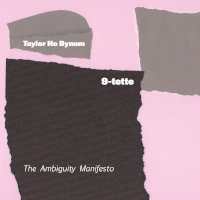 Taylor Ho Bynum continues to blur the line between composition and improvisation on The Ambiguity Manifesto, fusing genres and styles with an assortment of instrumental pairings. Bynum describes this as the concluding chapter of an “accidental trilogy” documented by Firehouse 12 Records, beginning with Navigation (2013), featuring his Sextet and 7-tette, and continuing with Enter the PlusTet (2017), which starred his 15-piece creative orchestra. The work reflects Bynum’s poly-stylistic approach, drawing on lessons gleaned over two decades working with innovators like Anthony Braxton, Bill Dixon, and Cecil Taylor. If Bynum took anything from that time, it would be the use of modular structures, which allow his ensembles to fragment, extrapolating variations on pre-written material in smaller configurations.
Taylor Ho Bynum continues to blur the line between composition and improvisation on The Ambiguity Manifesto, fusing genres and styles with an assortment of instrumental pairings. Bynum describes this as the concluding chapter of an “accidental trilogy” documented by Firehouse 12 Records, beginning with Navigation (2013), featuring his Sextet and 7-tette, and continuing with Enter the PlusTet (2017), which starred his 15-piece creative orchestra. The work reflects Bynum’s poly-stylistic approach, drawing on lessons gleaned over two decades working with innovators like Anthony Braxton, Bill Dixon, and Cecil Taylor. If Bynum took anything from that time, it would be the use of modular structures, which allow his ensembles to fragment, extrapolating variations on pre-written material in smaller configurations.
The 9-tette includes all of Bynum’s Sextet: Bynum (cornet); Jim Hobbs (alto saxophone); Bill Lowe (bass trombone and tuba); Mary Halvorson (electric guitar); Ken Filiano (acoustic bass); and Tomas Fujiwara (drums) – augmented by PlusTet members Ingrid Laubrock (soprano and tenor saxophones) and Tomeka Reid (cello), along with Stomu Takeishi on electric bass guitar. The instrumentation features an array of doubles: high and low duos in the brass and woodwind sections; four horns and four strings; electric and acoustic strings; four treble clef and four bass clef instruments – all pivoting around Fujiwara’s drum kit. The diverse line-up draws experience from different generations and artistic communities yet cooperates with a collective purpose.
The first half of the album establishes the basic material: in-the-pocket grooves; contrapuntal charts; probing abstractions. On the second half, variations on these episodic compositions are radically deconstructed. The opener, “Neither When nor Where”, sways with an infectious R&B rhythm that effortlessly integrates strings and horns. The same riff can be heard again briefly in its counterpart, “Enter (g) Neither,” an atmospheric tone poem. “Enter Ally” and “Ally Enter” are inverse mirrors; the first offers frenetic call-and-response, the second a pointillist meditation. “Real/Unreal” (for Ursula K. Le Guin) and the closing “Unreal/Real” (for Old Music) form another pairing. The former’s solemn mood gradually becomes more optimistic, with chamber-like strings and lush horn tuttis accentuated by Halvorson’s pedal-driven flourishes, before the leader closes the homage to the late American writer on a stately note. The latter variation recycles elements of the former, with a strong lyrical character punctuated by the saxophonists’ acerbic contributions. The epic centerpiece, “G(host) (aa/ab),” offers an intense series of free improvisations bathed in a miasma of hazy electronics. A hushed interlude reveals Bynum’s muted volleys, Laubrock and Lowe’s conversational exchanges, and eventually, Halvorson’s coruscating assault. Underscored by a frenzied vamp and gutbucket horns, the guitarist’s reverberating wall of sound slowly recedes for Bynum and Hobbs’ syncopated coda.
Malleable music for midsize ensembles has become Bynum’s specialty. Abstract at times, accessible at others, Bynum and company have created an album that expands time one moment, only to lock down a groove the next. For all its compositional complexity and genre-defying verve, there is resounding clarity to the project. The Ambiguity Manifesto is a testament to an exceptional bandleader and the unparalleled company he keeps.
–Troy Collins
Gerald Cleaver + Violet Hour
Live at Firehouse 12
Sunnyside SSC 1565
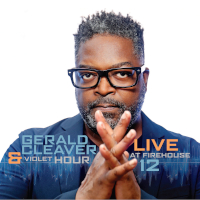 The last few albums I’ve heard that featured Gerald Cleaver have all been to the free/avant-garde side of things, so when I popped his new album into my player I was surprised to find a somewhat straight ahead blowing session. I was unfamiliar with his band Violet Hour, and after seeing the personnel (JD Allen, tenor; Andrew Bishop, reeds; Jeremy Pelt, trumpet; Ben Waltzer, piano; and Chris Lightcap, bass), I was even more surprised to see that the album was recorded in December of 2006, as it’s a pretty killer lineup for any band playing in 2019. As it turns out, Live at Firehouse 12 was recorded the same month as Gerald Cleaver’s Detroit, which featured the same ensemble and was released on Fresh Sound New Talent in 2007.
The last few albums I’ve heard that featured Gerald Cleaver have all been to the free/avant-garde side of things, so when I popped his new album into my player I was surprised to find a somewhat straight ahead blowing session. I was unfamiliar with his band Violet Hour, and after seeing the personnel (JD Allen, tenor; Andrew Bishop, reeds; Jeremy Pelt, trumpet; Ben Waltzer, piano; and Chris Lightcap, bass), I was even more surprised to see that the album was recorded in December of 2006, as it’s a pretty killer lineup for any band playing in 2019. As it turns out, Live at Firehouse 12 was recorded the same month as Gerald Cleaver’s Detroit, which featured the same ensemble and was released on Fresh Sound New Talent in 2007.
By 2006 Allen, Lightcap, and Bishop had only recorded two albums each as a leader, and Pelt and Waltzer both had four under their belts, so the release of Live at Firehouse 12 is, in a way, the opening of a time capsule that gives the listener greater context into the evolution of their careers. It’s no surprise the band is tight; as many of the band members had previously recorded with each other and continued to do so in the years that followed.
The sextet turns in snappy and scintillating performances of five of Cleaver’s compositions. It opens with “Pilgrim’s Progress,” an up-tempo piece with a short launchpad head that sets up a merry-go-round of brief solos, including a couple blistering statements from Pelt and Allen. A couple of the compositions are deceptively tricky. The rhythm section sets up “Tale of Bricks” – most of which is in an easy swinging eleven – with a piano solo played over loose time that Lightcap and Cleaver mold like clay. As the time settles in the tune builds in intensity and gives Pelt, Bishop (on bass clarinet), and Allen room to stretch their legs. The set concludes with “Detroit,” anther tricky piece with sections that alternate between 7 and 4. Like “Tale of Bricks,” Allen and Pelt show why they are two of the premier players in the business.
Throughout the album Cleaver subtly hints at other meters, plays different patterns and fills across bar lines, and puts accents in unexpected places. His playing might have tripped up other, lesser qualified bandmates, but in this band, his sneaky inventiveness serves to elevate the members of Violet Hour as a whole. It’s no wonder his resume reads like a who’s who list of the most forward thinking players in jazz and improvised music.
It’s a shame we had to wait 13 years to hear this spirited and dynamic album. Would it be too much to ask Cleaver to get the band back together?
–Chris Robinson
Bill Cole and the Untempered Ensemble
Music for Yoruba Proverbs
billcole.org
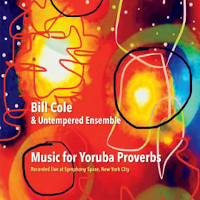 It’s good to have this 1986 concert recording featuring Bill Cole’s compositions arranged by Julius Hemphill made public. Cole’s music always makes provocative connections between musics from around the world, so the material has plenty of ideas to inspire Cole’s all-star ensemble. These compositions use the speech patterns of the proverbs in the melodies. You can sense the words “One should not go to bed with the roof on fire” as the band plays the tune, for instance. The rhythms driving the music come from different corners of the African diaspora, giving the music a global reach. Cole extends that reach eastward playing a range of reed instruments from non-Western cultures. His discovery of sonic parallels to the blues and the vocal inflections of jazz on Korean and Chinese instruments underscores bitter hope and celebratory humanity that underlies all music. Every time he plays, he stages an uprising of non-European and folk cultures demanding respect and equality.
It’s good to have this 1986 concert recording featuring Bill Cole’s compositions arranged by Julius Hemphill made public. Cole’s music always makes provocative connections between musics from around the world, so the material has plenty of ideas to inspire Cole’s all-star ensemble. These compositions use the speech patterns of the proverbs in the melodies. You can sense the words “One should not go to bed with the roof on fire” as the band plays the tune, for instance. The rhythms driving the music come from different corners of the African diaspora, giving the music a global reach. Cole extends that reach eastward playing a range of reed instruments from non-Western cultures. His discovery of sonic parallels to the blues and the vocal inflections of jazz on Korean and Chinese instruments underscores bitter hope and celebratory humanity that underlies all music. Every time he plays, he stages an uprising of non-European and folk cultures demanding respect and equality.
The octet assembled on the double CD includes Cole, Hemphill, Olu Dara, Abdul Wadud, Warren Smith, Joe Daley, Gerald Veasley, and Hafiz Shabazz. They hadn’t worked together before as a unit but knew one another, so a warm, collective spirit and a precise looseness borne of familiarity and shared values suffuses their playing. That communal feeling is not to be underestimated – in many ways it’s the core from which the music emanates. The layered rhythm foundation built up by electric bass, cello, drums, percussion, and euphonium elevates Cole’s soloing on “He who beats a drum for a madman to dance is no better than the madman” (hear that Congressional Republicans?). On “A tormentor makes his victims hardy,” the horns join in as they wish as Daley and Hemphill solo, climaxing in powerful group improvisation.
“A man sees a snake, a woman kills it; no matter as long as it is dead” features a Hemphill solo that captures the essence of the blues in a radical setting (no one did this quite as well as him). Daley displays his luscious lyrical side and an irresistible sense of rhythm on the upbeat “To live with a humble man refreshes the spirit.” The leader encapsulates the spirit of the music each time he solos. His keening, joyful sound and gritty textures, coupled with his swinging phrasing, on “To sow is to reap, one who excretes on the road finds flies when they return” liberate the ideals and aspirations of his unique vision and let them soar.
–Ed Hazell
Kris Davis
Diatom Ribbons
Pyroclastic Records PR06
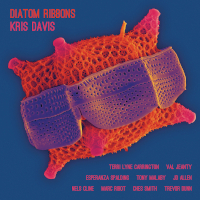 Diatom Ribbons is pianist Kris Davis’ third release as a bandleader on her own Pyroclastic imprint. The album is named after a marine-biological process whose optics vary from different points of view, and thus contains work of a constantly fluctuating nature. Featuring musicians from across the spectrum of creative improvised music, this eclectic session is the culmination of almost two decades worth of collaboration. Although Davis began her career working alongside avant-garde stalwarts like Ingrid Laubrock, Tony Malaby, and Tyshawn Sorey, that hasn’t prevented her from establishing connections with musicians outside the Downtown scene. This effort offers further evidence of her ability to transcend stylistic boundaries, with one of the most intriguing personnel line-ups in recent memory.
Diatom Ribbons is pianist Kris Davis’ third release as a bandleader on her own Pyroclastic imprint. The album is named after a marine-biological process whose optics vary from different points of view, and thus contains work of a constantly fluctuating nature. Featuring musicians from across the spectrum of creative improvised music, this eclectic session is the culmination of almost two decades worth of collaboration. Although Davis began her career working alongside avant-garde stalwarts like Ingrid Laubrock, Tony Malaby, and Tyshawn Sorey, that hasn’t prevented her from establishing connections with musicians outside the Downtown scene. This effort offers further evidence of her ability to transcend stylistic boundaries, with one of the most intriguing personnel line-ups in recent memory.
Davis worked with saxophonist JD Allen during the 2017 Thelonious Monk centennial, who appears here alongside drummer Terri Lyne Carrington and vocalist (and bassist) Esperanza Spalding, with whom Davis performed the following year in tribute to the late pianist Geri Allen. Carrington and Davis subsequently played with DJ Val Jeanty at the Stone in Carrington’s first fully improvised concert. Marc Ribot, whom Davis met while performing John Zorn’s Bagatelles, and guitarist Nels Cline (introduced by producer Ron Saint Germain), also make guest appearances. These new colleagues are joined by longtime associates Malaby (on tenor saxophone), percussionist Ches Smith (on vibraphone), and bassist Trevor Dunn. With such eclectic talent at her disposal, Davis has ample opportunity to harness her impressive writing skills; “all-star” projects often rely on name-recognition, whereas Davis uses each musician’s strength as a compositional tool, offering her bandmates space to shape ideas in their own voice.
Although startling on first listen, the stylistically diverse results cohere seamlessly thanks to the core trio of Davis, Carrington, and Jeanty, who provide a protean rhythm section for the rotating cast. Carrington’s hard-hitting technique anchors some of Davis’ most rhythmic writing to date; her shape-shifting approach alternates between swing, funk, and rock, instilling these tunes with a propulsive forward momentum. Of Jeanty, Davis says “her hip-hop influence, being able to shape the music using words ... opened a whole new palette for me ... I wanted Val to use words that were personal to me, by people whom I deeply respect and consider some of my deepest influences.” Jeanty manipulates recorded interviews with Cecil Taylor and Olivier Messiaen, blending them into a hybrid soundscape, while her electronic effects provide texture, adding depth and nuance. All her contributions are integrated organically – no easy feat considering the sonic disparity between hip-hop and acoustic jazz.
Past and present merge on the title cut, which begins with Davis’ looping prepared piano figure and Carrington’s metronomic beat, while Jeanty samples melodious spoken phrases from Taylor explaining his radical approach towards composing and how “For me, music saved my life.” Dunn joins as twin tenors establish the oblique theme, soloing forcefully in turn. Other highlights abound throughout the date: Spalding’s breathy vocals elevate a cover of Michael Attias’ ballad “The Very Thing,” and she delivers an intimate recitation of Gwendolyn Brooks’ poem “To Prisoners” at the outset of “Certain Cells,” while Davis and Carrington engage in a sublime Ellingtonian duet on “Sympodial Sunflower.” Davis also works electric guitars into the mix, creating scorching fusion on “Rhizomes” with Cline, and offering Ribot two versions of the tumultuous “Golgi Complex” to deconstruct. Ribot’s aggressive attack on “Golgi Complex (The Sequel)” – and paired with Cline, on “Golgi Complex” – finds Davis matching the guitarists’ pyrotechnics, channeling Taylor. The album closes with a dramatically episodic rendition of Julius Hemphill’s elegiac “Reflections,” with ecstatic solos from Malaby and Allen, and a righteous groove from Carrington providing an exhilarating finish. Expertly realized by a diverse cast, Diatom Ribbons documents a creative peak for Davis, elevating her skills as an improviser, composer, and bandleader to a new level.
–Troy Collins
Max Eastley + Fergus Kelly + Mark Wastell
The Map is Not the Territory
Confront Core Series Core 08 CD
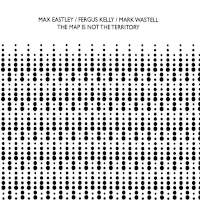 Any opportunity to hear a new recording by Max Eastley is a rare treat. Since the late ‘60s, Eastley’s been assiduously developing and evolving a personal synthesis of kinetic sculpture, environmental sound art, site-specific performances, invented instruments, and improvisational practice. Over that time, he’s performed fairly regularly, presented sound installations worldwide, and participated in art/science expeditions as part of the Cape Farewell Climate Change project. But recordings have been sporadic, this being his first in almost a decade. This time out, Eastley plays arc (his self-designed electro-acoustic monochord), joined by two collaborators who fit perfectly with his sensibility toward the resourceful mining of subtle approaches to deliberately-paced, sonic exploration. Dublin-based visual artist/composer/improvisor Fergus Kelly credited with “invented instruments, found metals, and electronics” works regularly in these sorts of improvised settings as well as developing multi-channel soundworks and radio pieces. Mark Wastell on tam tam, metal percussion, and “piano frame,” has long been investigating these strategies in a multitude of settings and impeccably rounds things out. The three have worked together in various formations over the last several decades and this recording effectively embodies their collective perspective.
Any opportunity to hear a new recording by Max Eastley is a rare treat. Since the late ‘60s, Eastley’s been assiduously developing and evolving a personal synthesis of kinetic sculpture, environmental sound art, site-specific performances, invented instruments, and improvisational practice. Over that time, he’s performed fairly regularly, presented sound installations worldwide, and participated in art/science expeditions as part of the Cape Farewell Climate Change project. But recordings have been sporadic, this being his first in almost a decade. This time out, Eastley plays arc (his self-designed electro-acoustic monochord), joined by two collaborators who fit perfectly with his sensibility toward the resourceful mining of subtle approaches to deliberately-paced, sonic exploration. Dublin-based visual artist/composer/improvisor Fergus Kelly credited with “invented instruments, found metals, and electronics” works regularly in these sorts of improvised settings as well as developing multi-channel soundworks and radio pieces. Mark Wastell on tam tam, metal percussion, and “piano frame,” has long been investigating these strategies in a multitude of settings and impeccably rounds things out. The three have worked together in various formations over the last several decades and this recording effectively embodies their collective perspective.
The recording, deftly captured at Studio 3 in London in March 2017, is comprised of eight pieces which span 45 minutes. And while each probe particular aspects of meticulously deployed textures, reverberation, and sustain they are woven together into a mercurial suite-like whole. Picking out individual contributions becomes next-to-impossible and really beside the point as the three patiently navigate their way through the gradually transforming skeins of bowed metal, microtonal string shudders, pulsating overtones, pin pricks of percussion, struck bells and gongs, and electronic shadings. The specific auditory nature of the instruments they have assembled are integral to the music, but it is the way they deploy them, with imperturbable symbiotic assurance, that makes this such an engaging listen.
One thing of note here is how the trio traverses their way across time. Bereft of any standard momentum or arc, the pieces are still imbued with a considered sense of progression. Subtle eddies and sonic ripples undulate as the intersections of changeable layers of sound gather and disperse. The three home in on an organic acuity toward pace and density. They have a keen ear toward how their sounds cooperatively accrue, letting things sit, and minutely nudging the amassed and overlapping layers of resonance and decay. There is nothing ambient about this music. Instead, it is imbued with their approach toward plying a simmering dynamism to collective, evolving, spontaneous soundscapes.
–Michael Rosenstein